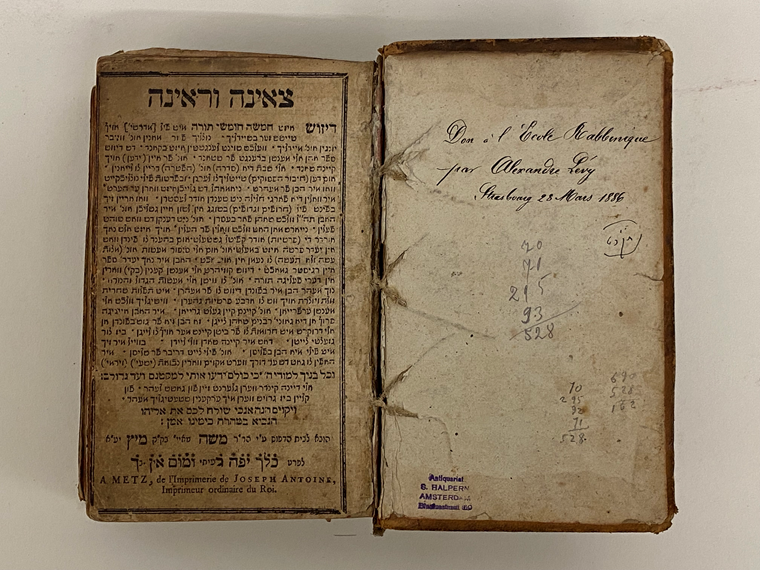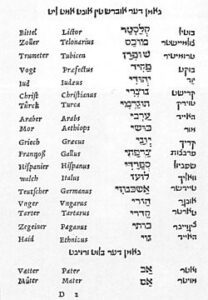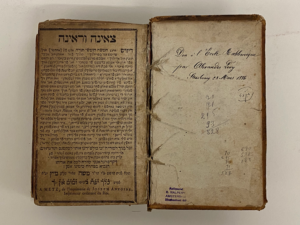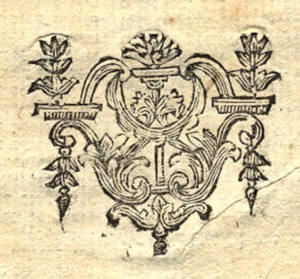The Tsenerene
The Tsenerene (alternatively written as Tz'enah Ur'enah), was one of the most popular and influential Yiddish literary works to emerge in the Middle Ages.

My name is Hannah, and I am a Learning Placement Volunteer at the Jewish Museum London. Throughout my three-month placement I have had the opportunity to contribute to a variety of educational activities at the museum and to experience different aspects of the role of a museum professional. One of the most memorable days of my placement was the museum wide research day during which each member of staff spent a workday researching an object/s of their choice from the museum’s collection.
My object of choice was an 18th century religious text commonly known as the Tsenerene.
Context:
The Tsenerene (alternatively written as Tz’enah Ur’enah), was one of the most popular and influential Yiddish literary works to emerge in the Middle Ages. It is a Yiddish-language prose adaptation of the weekly Torah portions interwoven with Midrashic (ancient rabbinic) commentary, along with the corresponding Haftarah (a short reading from the Prophets) portions and the five Megillot.
The Tsenerene came to be ‘one of the most well-known and beloved works of Eastern European Jewry’ (Kahn, 2016).
The Tsenerene was first written by Jacob ben Isaac Ashkenazi (1550–1625) of Janów Lubelski (near Lublin, Poland), towards the end of the 16th century. The exact date of composition and the first printing are unknown, but the earliest extant edition dates to 1622.
The Tsenerene has traditionally been printed in a mixture of square Hebrew script for the Hebrew portions and Mashkit font for the Yiddish parts. The Jewish Museum London’s edition is thus written in a mixture of Hebrew (for prayer and Torah extracts) and Yiddish (for commentary and translation).
Script/font:
The special Mashkit font used for the Yiddish sections of the Tsenerene is a semi-cursive script typeface for the Yiddish alphabet, which distinguished Yiddish publications from the 16th until the early 19th century.
Although they bare an strong resemblance, the Mashkit font is not to be confused with the very similar looking Rashi script, which is a cursive Hebrew script traditionally used for Rashi commentaries on the Tanakh and Talmud and for Ladino (Judeo-Spanish) printing (Kamusella, 2009).

Mashkit Yiddish font

Yiddish Alphabet in Square Hebrew script
Women:
Mashkit was also known as Vaybertaytsh ( lit. ’women’s taytsh’– i.e the Yiddish used by women) due to the fact that it was used as the primary script in texts for and by Yiddish speaking Jewish women. Women were usually fluent only in Yiddish, as opposed to men who often studies in Hebrew in schools and Yeshivot (Orthodox Jewish colleges for men).
This was due to a Talmudic interpretation adopted by a vast majority of Medieval and Early-Modern rabbis, which strongly discourages women from engaging in in-depth Torah study (Babylonian Talmud, Kiddushin 29b) which, in turn, requires a good standard of Hebrew language skills. Jewish women’s religious education only saw a shift at the beginning of the 20th century due to increased secularisation of religious women through the secular education system. Today, the majority of orthodox Jewish women are educated in both Hebrew language and Bible studies.
Because women (in general) could only read in Yiddish, if at all, early religious works in Yiddish were mostly aimed towards women; the Tsenerene included. In fact, the very name Tsenerene is derived from a verse in the biblical book of the Song of Songs (3:11) that begins:
צְאֶנָה וּרְאֶינָה בְּנוֹת צִיּוֹן /tsena u’reina bnot tzion (’Go forth and see, O ye daughters of Zion’). The source of the name solidifies the idea that the book was intended for women.
The Jewish Museum London Edition:

Inside cover and front page of Tsenerene JML, Object Number: 1985.69
The front page, printed in Hebrew, tells us the following:
:הובא לבית הדפוס ע׳י (על ידי) הר׳ר (הרב רבי) משה מאיי׳ בק״ק (קהילת קודש) מיץ יע״א (יחוננך עליון) אמן ,לפרט
כלך יפה געיתי ומום אין בך (שיר השירים, פרק ד׳ פסוק ז׳)
Translation: ‘Brought to the press-house by the great Rabbi Moshe from the Island (?) in the holy community of Metz, may the L-rd guard it/help it.
To describe (likely the community in question) ‘Every part of you is fair, my darling. There is no blemish in you’ (Song of Songs 4:7)’
Underneath this we find the publication details in French:
‘A METZ, de l’Imprimerie de Joseph Antoine, Imprimeur ordinaire du Roi’
Translation: ‘At Metz (A city in northeast France), from the printing house of Joseph Antoine, the King’s Printer’
Based on the above we know that the Tsenerene in the Jewish Museum London’s (JLM) collection was printed in the French city of Metz, in the printing house of Joseph Antoine ‘Imprimeur ordinaire du Roi,’ i.e., the King’s printer.
The ‘King’s Printer’ was a title that first emerged in 1538 and was given to a printer from Paris, the provinces or the colonies who enjoyed a unique status and was granted certain privileges from the royal administration. The title officially disappeared with the abolition of corporations (1776) and the decree of Allarde (1791).
Joseph Antoine was born in 1715 and became the ‘King’s Printer’ in 1758 as well as a printer of l’académie royale des sciences et des arts (de Metz) – the royal academy of science and art (of Metz). He died in 1785.

Stamp of Joseph Antoine
This leads us to conclude that this book was printed in between 1758 and 1785, from when Joseph Antoine became the King’s printer to when he died. This is corroborated by the original Object Entry Form for this book, from when it was donated to the museum in May 1985, which states that it dates to before 1789.
Additionally, the stamp on the inside of the book cover indicates that, prior to its donation to the Jewish Museum, the book was previously bought from a shop in Amsterdam in the 1980s and, before this, was given as a gift to ‘the Rabbinic school’ by Alexandre Levy, in Strasbourg on the 28th of March 1886 (according to the dedication in French on the top of the inside cover).
The book is divided as follows:
The beginning consists of prayers for Shabbat and Rosh Chodesh (the beginning of the Jewish month) with Yiddish commentary interspersed (e.g., when the Hazan does this the one praying should do this); this is followed by a series of Yotzer prayers for important Shabbatot; which is then followed by the entirety of the books of Genesis through to Deuteronomy with the appropriate Haftarot (weekly readings from the books of Prophets) throughout. The book is completed by the five Megilot (the books of Esther, Song of Songs, Ruth, Lamentations, and Ecclesiastes) all in Yiddish with rabbinic interpretations and a portion titled the ‘The Destruction of the Temple.’ The book also features a few prints (a fruit bowl on page 36 for example).
I have immensely enjoyed researching and learning about the Tsenerene, both in general and with regards to this particular edition, looking into its history and geographical journey. From the printing house in 18th century Metz (where it was likely used by the local Jewish community), to the Rabbinic school in Strasbourg in 1886, then to a shop in the 1980’s Amsterdam and finally to the Jewish Museum London since May 1985.